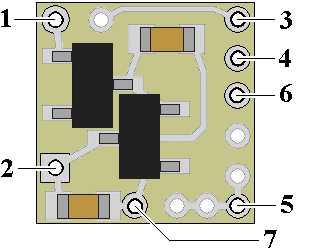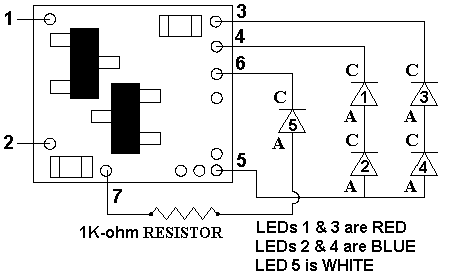Best viewed using:
Internet Explorer
or
Mozilla Firefox
Connecting the Police Motorcycle dual flasher w/headlight (early-era)
The N8081 is designed to alternately light 2 series-pairs of LEDs, (1 red & 1 blue in each pair) to simulate the emergency lights on the front & rear of police motorcycle, circa 1950’s. Solder points 3,4 & 5 drive these LEDs. An additional output is provided for a white LED for a headlight at points 6 & 7.
Installing
the N8081
is very straightforward. Because the module has circuitry on both sides, care
must be taken to be sure that the components or wires soldered will not make
contact with any metal object which could cause a short
circuit.
Included
with the module are two 6” lengths of #32 insulated wire. If necessary, these
can be used for power input wires. If used, we recommend the red
wire be used for the + DC connection. It would be connected to solder point
1 as shown in Fig. 1. This wire could also connect through a switch
to the + DC connection for remote control of the lighting effect. The other (black)
wire should be connected to – DC and to solder point
2.

Figure 1
Important note: A low-wattage iron with a pointed tip should be used for connection of wires. Too much heat or solder can easily damage the wires, decoder or module and void the warranty.
Also, all connecting wires should be pre-tinned before soldering them to the module. This will make connection quick and easy and ensure excessive heat is not applied to the solder points.
Connecting LEDs
When
connecting the LEDs, proper polarity must be observed. LEDs are “polarity
sensitive” and will not function if connected backwards.
The N8081
is configured for the connection of
2 series pairs of
20 ma LEDs
(1 red & 1 blue in each pair)
to solder points
3,
4
&
5.
The N8081
has on-board current limiting resistance to protect these LEDs so no external
resistor is required.
Using wire appropriate for the size of the LEDs and their placement in your project, connect the LED anodes (A) and cathodes (C) together as shown in Figure 2 below. Note that LEDs 1 & 2 are a series pair (wired anode to cathode) and LEDs 3 & 4 are a second series pair. Anodes of LEDs 2 & 4 are connected in common to solder point 4. Additionally, a 5th LED (white type) is connected between points 6 & 7 with a 1K-ohm resistor in series as shown below. This resistor is included with the package (plus a spare)

Figure 2
This
completes hookup of our N8081
module. We hope the aded realism it provides enhances your enjoyment of the
hobby.
If you need
assistance or have questions, please contact: nsupport@ngineering.com
For product
warranty details please visit:
www.ngineering.com
© 2025 Ngineering





















